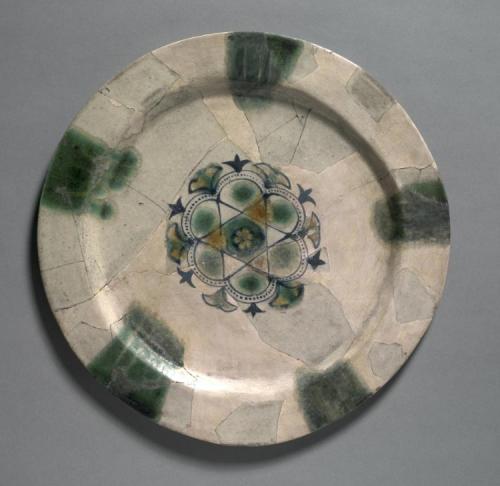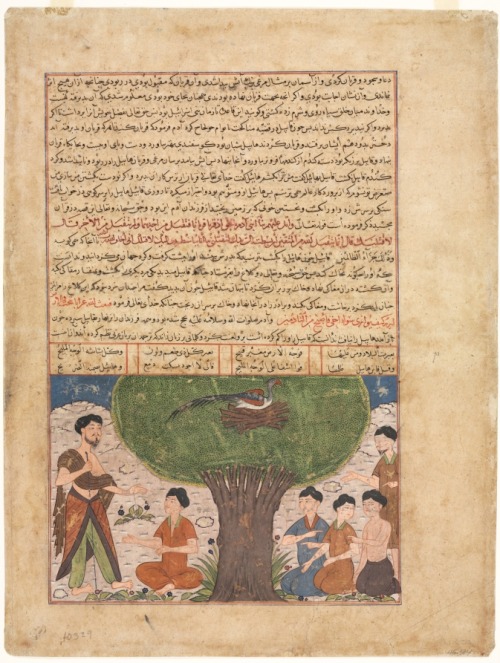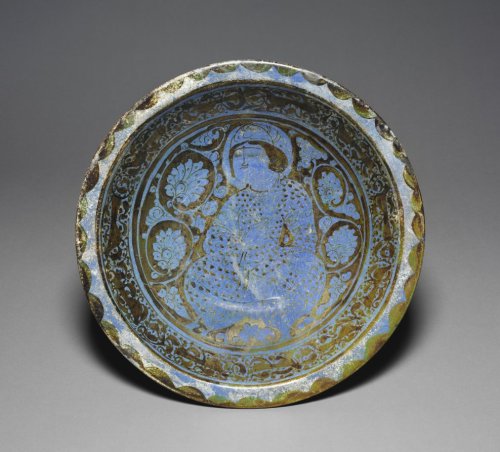#islamicart
Fragment,Islamic Art
Medium: Linen, wool; plain weave, tapestry weaveRogers Fund, 1927 Metropolitan Museum of Art, New York, NY
http://www.metmuseum.org/art/collection/search/448128
Post link
Bottle,Islamic Art
Medium: Glass; mold blown; tooled on the pontilRogers Fund, 1922 Metropolitan Museum of Art, New York, NY
http://www.metmuseum.org/art/collection/search/447465
Post link
Fragment,Islamic Art
Medium: LinenGift of Lily S. Place, 1921 Metropolitan Museum of Art, New York, NY
http://www.metmuseum.org/art/collection/search/447326
Post link
Panel, late 15th century,Metropolitan Museum of Art: Islamic Art
Rogers Fund, 1907
Size: H. 3 ¼ in. (8.3 cm)
Medium: Wood; carved, inlaid with ivory
Post link
Luxury Inlaid Container, c. 1250-1350,Cleveland Museum of Art: Islamic Art
Silver and gold inlay transforms this brass box into a luxury container. Courtiers, birds, and fretwork form the decoration while inscriptions extend good wishes. On the body it reads: “Brilliance, and nobility, and patience, and modesty, and glory, and long life, and piety, and patience.”
Size: Diameter: 11.4 cm (4 ½ in.); Overall: 12 cm (4 ¾ in.); Diameter of box: 10.1 cm (4 in.); Box: 9.7 cm (3 13/16 in.)
Medium: sheet brass, inlaid with silver and gold
Post link
Textile Fragment, 6th century,Metropolitan Museum of Art: Islamic Art
Gift of George F. Baker, 1890
Medium: Wool, linen; tapestry weave
Post link
Illuminated Folio from a Gulistan (Rose Garden) of Sa'di (c. 1213-1291), Sultan Muhammad, c. 1525-30,Cleveland Museum of Art: Islamic Art
TheGulistan,completed around 1258, is one of the most celebrated works of Persian literature. The book’s name means “rose garden” in Persian; just as a rose garden is a collection of flowers, the contents are a collection of anecdotes. Written in both prose and verse, the Gulistanwas used for centuries as a primer for schoolchildren in greater Iran, India, and Turkey. The text on these pages is written in nastaliqscript and comes from the first chapter, “On the Conduct of Kings.”
The exquisite borders of these two folios show lions, dragons, foxes, and peacocks in a lush landscape, painted in gold and silver that has tarnished over time.
Medium: opaque watercolor, ink, gold and silver on paper
Post link
عن ابن عباس - رضي الله عنهما - قال:
قال رسول الله - صلى الله عليه وسلم -:
{أُريت النار، فإذا أكثر أهلها النساء يكفرن قيل: أيكفرن بالله؟ قال: يكفرن العشير، ويكفرن الإحسان ، لو أحسنت إلى إحداهن الدهر ثم رأت منك شيئا قالت: ما رأيت منك خيرا قط}.
[صحيح بخاري :29ص104].
العشير: الزوج.
لا إله إلا الله …
كنت أقرأ يوما في صحيح البخاري …
فاستوقفني هذا الحديث …
نعم …
لقد أدهشني هذا الحديث …
بعد ذلك …
تأملت واقع بعض نساءنا فوجدت أن حالهم ينطبق عليه هذا الحديث …
يا الله …
لقد خشيت على والدتي من النار …
لقد خشيت على أخواتي وأقاربي من النار …
لقد خشيت على نساء المسلمين من النار …
بعد هذا التأمل !
قرأت هذا الحديث مرّة ومرتين وثلاثة بل حفظته ، ثم نقلته لأهلي …
فقلت لم لا أنقله لأخواتي المسلمات من أجل تذكيرهم ونصحهم حتى لا يكن من أهل النار …
أيتها المرأة الغالية !!
أرجوا أن تقرئي هذا الحديث الآن *
ــــــــ ـــــــــ
لعلكِ فهمتي ما يقصد هذا الحديث *
أختي المسلمة /
… الآن …
أعيدي شريط الذكريات من المواقف التي أنكرتي فيه إحسان زوجكِ أو أبيكِ أو أحد إخوانِك …
سواء كان ذلك ( أي الجحود ) مشافهة ً معهم **
أو
كان ذلك عن طريق سماعة الهاتف مع زميلاتك **
أو
كان ذلك مع والدتك ، وأخواتك **
أو
كان ذلك عن طريق معاملتك السيئة مع والد أو والدة زوجك ، أو أبناء إخوانك **
أو
كان ذلك عن طريق التعامل السيئ مع أي فردٍ منهم **
أو أو أو …
أرجوا أن تتذكري … وتتأملي في أحوالك …
لا تستعجلي …
لا تستعجلي …
إذا تذكرتي وانتهيتي …
فأرجوا أن تعيدي قراءة حديث الرسول صلى الله عليه وسلم …
أيها الغالية … أنتِ تريدين الجنة ولا شك في ذلك …
فما هي لمساتكِ بعد هذا الحديث …
أولا ً /
استغفري الله وتوبي إليه ، واعلمي أن هذا دين العدل ، ودين الرحمة ، ودين المحبة …
توبي إلى الله عز وجل توبة صادقة لا رجعة فيها …
فيا حسرة من كانت النار مسكنها بسب جحودها لإحسان لزوجها أوإحسان غيره …
نعم قد تكوني من الصالحات وقد تكوني من الداعيات لكن قد تكوني مبدعة في فن الجحود وإنكار الجميل …
ثانياً /
عودي نفسك على الإحسان لزوجك مهما بدر منه ، وأيضا ربّي نفسك على عدم الجحود سواء كان ذلك لله عز وجل ، أو للزوج أو للمخلوقين …
ولقد دعتني للخلاف عشيرتي.. … ..فعددت قولهم من الإضلال
إني امرؤٌ فيَّ الوفـــــاء سجيـة.. … .وفعــال كل مهـذب مفضـال
ثالثاً /
أشكري زوجك على أفعاله الحسنة ، وذكريه بما فات من معروفه الذي قدّمه لكِ ، أو قدّمه لأهلِك ، فالرسول صلى الله عليه وسلم يقول( من لا يشكر الناس لا يشكر الله ) ، وأيضاً لا تنسي أبيكِ ومن له حقٌ عليكِ … ويقول الرسول صلى الله عليه وسلم ( من أعطي عطاء فوجد فليجز به ، ومن لم يجد فليثن ، فإن من اثنى فقد شكر ، ومن كتم فقد كفر ، ومن تحلى بما لم يعطه كان كلابس ثوبي زور ) صححه الألباني
رابعا /
إذا كان زوجك أو أحد أقاربك له صفات ذميمة ، أو تعامل سيئ ، أو أنكر لكِ جميلا فقابلي ذلك بالصبر والإحسان …
فالجميل كإسمه، والمعروف كرسمه، والخير كطعمه …
خامسا ً /
ابتعدي عن كثرة الجدال … لأن ذلك قد يفضي أثناء غضبك إلى الجحود والنكران … فالحبيب صلى الله عليه وسلم يقول ( أنا زعيم ببيت في ربض الجنة لمن ترك المراء وإن كان محقا ) .
سادسا /
لا تتفنني في زخرفة الخيال لديك بأهمية تأديب الزوج بهذا الأسلوب… وأن الرجال لا ينفع معهم إلا ذلك …
ولكن كوني امرأة صالحة منصفة …لا تجرح مشاعر زوجها ولا تنكر إحسانه …
أختي المسلمة /
بعد قراءتك وفهمك وحفظك لهذا الحديث …
لا تلبسي النظارة السوداء عندما يسود الخلاف بينكما ، فما يقع فيه بعض النساء من الخلاف الطبيعي بين الزوجين يجعل بعضهن تلبس هذه النظارة فلا ترى كل شيء على كيانه ….
فتجدها تخفي الحسن من أفعال ذلك الزوج ، وتظهر القبح …
و ما ينجر عليه بعض النساء من الجحود والنكران هو أن كل امرأة تبدأ تعرض لصديقاتها ذلك فتقول زوجي عصبي ( وهو إنسان له أخلاقه الحسنة لكنه غضب في أحد الأوقات ، فعلقت المرأة هذا الموقف على جميع محاسنه) .
أو أن تقول زوجي بخيل (لأنه رفض لها طلب غير مقتنع فيه أو لم يتيسر له مبلغ هذا الطلب آنذاك ومع ذلك يؤدي النفقة الواجبة واللوازم التي ينبغي أن ييسرها) .
أو غير ذلك من الأمثلة حيث تعلق بعض النساء موقف سلبي في حياة الرجل على مواقفه الإيجابية في حياته كلها …
أختي المسلمة /
القناعة كنز لا يفنى … فاقنعي بالقليل يأتيك الكثير ولا يملأ فم ابن آدم إلا التراب …
وتذكري عاقبة الغيبة فما سمعنا ولا قرأنا في كتاب الله ولا في سنة رسول الله شيئا يبيح ويحلل غيبة الزوج أو غيبة الرجال .
واعلمي أن الظلم ظلمات …
هذا ما أردت الإشارة إليه ، وإلا فمجرد قراءة هذا الحديث والتمعن فيه يكفي الكثير والكثير مما كتبت ومما لم أكتب …
“As long as the soup is good, do not worry if the bowl is pretty!”
Bowl with Persian Inscription (Iran), dated A.H. 779/ A.D. 1377, Stonepaste; blue and black painted under transparent glaze, Diam. 11 13/16 in. (30 cm) H. 3 ¾ in. (9.5 cm), Metropolitan Museum of Art, Purchase, Anonymous Gift, 1970, 1970.28
This bowl’s design includes a Persian inscription that reads, "As long as the soup is good, do not worry if the bowl is pretty!“ - An apt reminder that our purpose and what we contain are greater than our outward appearances.
Post link
Persian verses (recto) from a Haft Awrang (Seven Thrones) of Jami (d. 1492), mid 1500s,Cleveland Museum of Art: Islamic Art
A suite of five poems, the Khamsa (khamsa is five in Arabic), written in the 1100s, was, like the earlier Shahnama, concerned with the history and legends of pre-Islamic Iran. But Nizami’s interest was with love rather than war. In this, the second of the poems, he tells the story of these two famous star-crossed lovers. It is difficult to assign the illustrations here to specific episodes, but they may be concerned with Khusro’s stay at the court of Shirin’s aunt, the Queen of Azarbaijan. Shirin serves pomegranates to Khusro.
Size: Sheet: 29.6 x 16.2 cm (11 5/8 x 6 3/8 in.); Image: 21 x 13 cm (8 ¼ x 5 1/8 in.)
Medium: opaque watercolor, ink, and gold on paper
https://clevelandart.org/art/1947.500.a
Post link
Bowl with Two Birds, 900s,Cleveland Museum of Art: Islamic Art
Two facing birds painted with dark brown slip (clay diluted with water) on a plain white slip ground were a popular decoration in eastern Iran. A stylized Arabic word, baraka (blessing), appears on each bird’s body.
Size: Overall: 7.6 x 25 cm (3 x 9 13/16 in.)
Medium: earthenware with underglaze slip-painted decoration
https://clevelandart.org/art/1969.300
Post link
Earthenware Dish Painted Blue with Splashes of Green and Yellow, 830-900,Cleveland Museum of Art: Islamic Art
This dish displays two great technological advances of the ninth century: the invention of opaque white glaze (imitating Chinese porcelain) and painting in colbalt blue.
Size: Diameter: 30.2 cm (11 7/8 in.); Overall: 1.3 cm (½ in.)
Medium: earthenware with overglaze-painted design
https://clevelandart.org/art/1915.304
Post link
The Story of Adam, peace upon him, his Sons and Progeny, from a Jami al-tavarikh (Compendium of Chronicles) of Rashid al-din, c. 1425,Cleveland Museum of Art: Islamic Art
These two pages are from a manuscript that evidently was written and illustrated for the library (at Herat) of the Timurid king Shah Rukh, the son of Timur (Tamerlane). The Majma’ al-Tawarikh traced the history of the world, beginning with the prophets of the Old Testament until the reign of Shah Rukh.
Size: Image: 14.7 x 22.7 cm (5 13/16 x 8 15/16 in.); Overall: 42 x 32 cm (16 9/16 x 12 5/8 in.); Text area: 34.5 x 22.7 cm (13 9/16 x 8 15/16 in.)
Medium: opaque watercolor and ink on paper
https://clevelandart.org/art/1945.384.b
Post link
Royal Feast in a Garden, left folio from the double-page frontispiece of a Shahnama (Book of Kings) of Firdausi (940–1019 or 1025), c. 1440,Cleveland Museum of Art: Islamic Art
The painting on the verso of this folio is the first half of a double-page frontispiece now detached from a Shahnama (Book of Kings) manuscript. CMA 1956.10 is the left half of the frontispiece.
As though setting the scene for royal stories and activities, these two opening pages of Iran’s national epic present a luxurious gathering in an idyllic outdoor setting. Groups of nobles and international diplomats have come bearing gifts, including costly vessels and hunting animals. From the upper left two trained cheetahs, a falcon, and horses are led into the scene. Drama and intrigue seem to be brewing, given the knowing glances and whispers between figures and the four men being driven away by a guard at the lower left.
Size: Recto Image: 26.1 x 20.7 cm (10 ¼ x 8 1/8 in.); Overall: 32.7 x 22 cm (12 7/8 x 8 11/16 in.)
Medium: opaque watercolor, ink, gold and silver on paper
https://clevelandart.org/art/1956.10
Post link
Luster Dish with Seated Prince, 1170-1220,Cleveland Museum of Art: Islamic Art
This dish is admired for its rare blue glaze design on a luster ground.
Size: Overall: 7.5 x 39 cm (2 15/16 x 15 3/8 in.)
Medium: fritware with luster-painted design
https://clevelandart.org/art/1951.289
Post link
Wall Tile, 14th Century,Cleveland Museum of Art: Islamic Art
Size: Overall: 40.5 x 25.5 x 4 cm (15 15/16 x 10 1/16 x 1 9/16 in.)
Medium: fritware with luster-painted design
https://clevelandart.org/art/1915.649
Post link
Mosque Lamp, 1585-1595,Cleveland Museum of Art: Islamic Art
These vessels have the shape of glass lamps intended for mosques and tombs, but since they are opaque and could have emitted no light, their function was purely decorative.
Size: Overall: 28.4 x 19.5 cm (11 3/16 x 7 11/16 in.); Diameter of rim: 17 cm (6 11/16 in.)
Medium: fritware with underglaze-painted design
https://clevelandart.org/art/1944.236
Post link
Incense Burner, 1st half 1200s,Cleveland Museum of Art: Islamic Art
Size: Overall: 10.6 cm (4 3/16 in.); Diameter of ridge at base: 8.8 cm (3 7/16 in.); Diameter of ridge at rim: 8.2 cm (3 ¼ in.)
Medium: brass inlaid with silver
https://clevelandart.org/art/1937.26
Post link
Khusrau Parviz Fleeing Bahram Chubineh and Being Saved by Angel Sarush (recto) from a Shahnama (Book of Kings) of Firdausi (940–1019 or 1025), c. 1299,Cleveland Museum of Art: Islamic Art
Size: Image: 5 x 13.2 cm (1 15/16 x 5 3/16 in.); Overall: 25 x 18.8 cm (9 13/16 x 7 3/8 in.)
Medium: opaque watercolor and ink on paper
https://clevelandart.org/art/1944.480.1.a
Post link



















